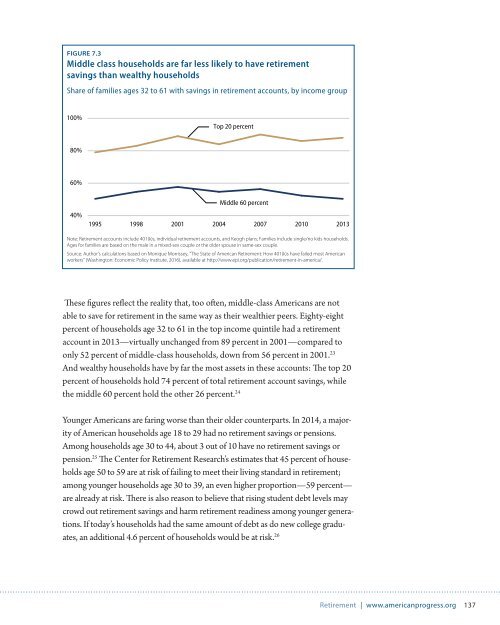AGENCY/PHOTOGRAPHER
RaisingWagesRebuildingWealth
RaisingWagesRebuildingWealth
You also want an ePaper? Increase the reach of your titles
YUMPU automatically turns print PDFs into web optimized ePapers that Google loves.
FIGURE 7.3<br />
Middle class households are far less likely to have retirement<br />
savings than wealthy households<br />
Share of families ages 32 to 61 with savings in retirement accounts, by income group<br />
100%<br />
Top 20 percent<br />
80%<br />
60%<br />
40%<br />
Middle 60 percent<br />
1995 1998 2001 2004 2007 2010 2013<br />
Note: Retirement accounts include 401(k)s, individual retirement accounts, and Keogh plans; Families include single/no kids households.<br />
Ages for families are based on the male in a mixed-sex couple or the older spouse in same-sex couple.<br />
Source: Author's calculations based on Monique Morrissey, "The State of American Retirement: How 401(k)s have failed most American<br />
workers" (Washington: Economic Policy Institute, 2016), available at http://www.epi.org/publication/retirement-in-america/.<br />
These figures reflect the reality that, too often, middle-class Americans are not<br />
able to save for retirement in the same way as their wealthier peers. Eighty-eight<br />
percent of households age 32 to 61 in the top income quintile had a retirement<br />
account in 2013—virtually unchanged from 89 percent in 2001—compared to<br />
only 52 percent of middle-class households, down from 56 percent in 2001. 23<br />
And wealthy households have by far the most assets in these accounts: The top 20<br />
percent of households hold 74 percent of total retirement account savings, while<br />
the middle 60 percent hold the other 26 percent. 24<br />
Younger Americans are faring worse than their older counterparts. In 2014, a majority<br />
of American households age 18 to 29 had no retirement savings or pensions.<br />
Among households age 30 to 44, about 3 out of 10 have no retirement savings or<br />
pension. 25 The Center for Retirement Research’s estimates that 45 percent of households<br />
age 50 to 59 are at risk of failing to meet their living standard in retirement;<br />
among younger households age 30 to 39, an even higher proportion—59 percent—<br />
are already at risk. There is also reason to believe that rising student debt levels may<br />
crowd out retirement savings and harm retirement readiness among younger generations.<br />
If today’s households had the same amount of debt as do new college graduates,<br />
an additional 4.6 percent of households would be at risk. 26<br />
Retirement | www.americanprogress.org 137


